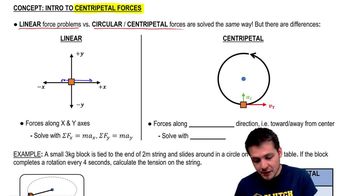Textbook Question
An airplane feels a lift force L perpendicular to its wings. In level flight, the lift force points straight up and is equal in magnitude to the gravitational force on the plane. When an airplane turns, it banks by tilting its wings, as seen from behind, by an angle from horizontal. This causes the lift to have a radial component, similar to a car on a banked curve. If the lift had constant magnitude, the vertical component of L would now be smaller than the gravitational force, and the plane would lose altitude while turning. However, you can assume that the pilot uses small adjustments to the plane's control surfaces so that the vertical component of L continues to balance the gravitational force throughout the turn. a. Find an expression for the banking angle θ needed to turn in a circle of radius r while flying at constant speed v.
887
views





